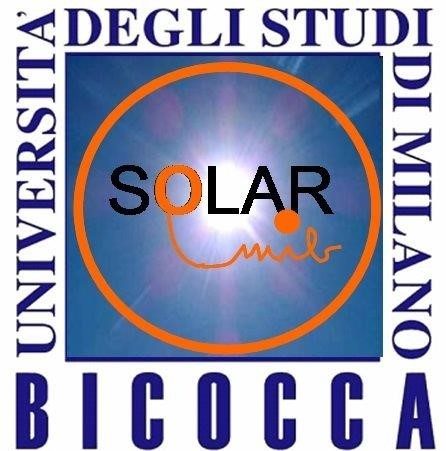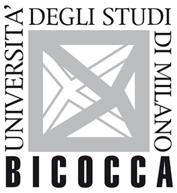 The research activity will be focused to the characterization, using simulated solar light, of semi-transparent photovoltaic modules based on luminescent solar concentrators (LSC). LSCs consist of polymeric waveguides doped or coated with chromophores (i.e. colloidal semiconductor nanocrystals or conjugated dyes). Sunlight is absorbed by such chromophores and re-radiated at longer wavelength inside the waveguides that concentrates it to its edges, where photovoltaic cells operate the optical-to-electrical conversion. Owing to their fully optical functioning mechanisms that does not require electrodes to be installed onto the device surfaces, LSC are particularly suitable for architectural integration in the form of ‘solar windows’, with no impact on the aesthetics of a building or on the quality of life of its inhabitants. The realization of highly efficient LSCs requires the optimization of the emitters, the waveguide, the optical outcoupling to the perimeter solar cells and the electrical conversion. In this research line, all these aspects are carefully considered to devise innovative technological solutions for increasing the device efficiency and to progress the fabrication processes in view of the prompt industrialization of state-of-the-art BIPV modules based on LSCs. This involves the design and realization of chromophores with broadband optical absorption for maximizing solar harvesting, high luminescence efficiency and suppressed re-absorption capability, so as to enable free propagation of the concentrated light in large area devices.
The research activity will be focused to the characterization, using simulated solar light, of semi-transparent photovoltaic modules based on luminescent solar concentrators (LSC). LSCs consist of polymeric waveguides doped or coated with chromophores (i.e. colloidal semiconductor nanocrystals or conjugated dyes). Sunlight is absorbed by such chromophores and re-radiated at longer wavelength inside the waveguides that concentrates it to its edges, where photovoltaic cells operate the optical-to-electrical conversion. Owing to their fully optical functioning mechanisms that does not require electrodes to be installed onto the device surfaces, LSC are particularly suitable for architectural integration in the form of ‘solar windows’, with no impact on the aesthetics of a building or on the quality of life of its inhabitants. The realization of highly efficient LSCs requires the optimization of the emitters, the waveguide, the optical outcoupling to the perimeter solar cells and the electrical conversion. In this research line, all these aspects are carefully considered to devise innovative technological solutions for increasing the device efficiency and to progress the fabrication processes in view of the prompt industrialization of state-of-the-art BIPV modules based on LSCs. This involves the design and realization of chromophores with broadband optical absorption for maximizing solar harvesting, high luminescence efficiency and suppressed re-absorption capability, so as to enable free propagation of the concentrated light in large area devices.
The compatibility between the chromophores and the polymeric waveguide is also a critical parameter in order to avoid the formation of defects or large chromophore aggregates that lead to optical losses by light scattering. Outcoupling of the propagating light is key for efficiently extracting optical power from the device and turn it into electricity. This step requires the use of proper index-matching adhesives that couple the LSC slab to the cells. Finally, the type of solar cells needs to be selected so as to match the wavelength of the concentrated light and provide sufficiently high operative voltage.
With these clear objectives in mind, the research follows an iterative [design→simulation→fabrication→testing] scheme. New design/processing criteria are first devised and their impact on the device behaviour is simulated numerically. Promising strategies are then concretely realized, and the materials/components are tested spectroscopically. The use of simulated solar light is the final crucial step of characterization of the optical and electrical performance of a complete LSC. This is performed systematically using different solar cells and index matchers, by testing the current output vs. the illumination level and device shadowing so as to evaluate the optical losses, if any, on a final device before on-field testing.
Research team: Prof. Sergio Brovelli (Associate Professor), Dr Francesco Carulli (Post-doctoral fellow), Dr Valerio Pinchetti (Post-doctoral fellow), Abhinav Anand (Post-doctoral fellow), Matteo Zaffalon (Post-doctoral fellow).
Selected publications:
- Meinardi, F., McDaniel, H., Carulli, F., Colombo, A., Velizhanin, K. A., Makarov, N. S., Simonutti, R., Klimov, V. I. &; Brovelli, S. Highly efficient large-area colourless luminescent solar concentrators using heavy-metal-free colloidal quantum dots. Nature Nanotechnology 10, 878-885, (2015).
- Pinchetti, V., Di, Q., Lorenzon, M., Camellini, A., Fasoli, M., Zavelani-Rossi, M., Meinardi, F., Zhang, J., Crooker, S. A. &; Brovelli, S. Excitonic pathway to photoinduced magnetism in colloidal nanocrystals with nonmagnetic dopants. Nature Nanotechnology 13, 145-151, (2018).
- Meinardi, F., Colombo, A., Velizhanin, K. A., Simonutti, R., Lorenzon, M., Beverina, L., Viswanatha, R., Klimov, V. I. &; Brovelli, S. Large area luminescent solar concentrators based on “Stokes-shift-engineered” nanocrystals in mass polymerized polymethylmethacrylate matrix. Nature Photonics 8, 392-399, (2014).
- Meinardi, F., Ehrenberg, S., Dhamo, L., Carulli, F., Mauri, M., Bruni, F., Simonutti, R., Kortshagen, U. & Brovelli, S. Highly efficient luminescent solar concentrators based on earth-abundant indirect-bandgap silicon quantum dots. Nature Photonics 11, 177-185, (2017).
- Meinardi, F., Bruni, F. & Brovelli, S. Luminescent solar concentrators for building-integrated photovoltaics. Nature Reviews Materials 2, 17072, (2017).
- Santiago-Gonzalez, B., Monguzzi, A., Azpiroz, J. M., Prato, M., Erratico, S., Campione, M., Lorenzi, R., Pedrini, J., Santambrogio, C., Torrente, Y., De Angelis, F., Meinardi, F. &; Brovelli, S. Permanent excimer superstructures by supramolecular networking of metal quantum clusters. Science 353, 571-575, (2016).
- Meinardi, F., Akkerman, Q. A., Bruni, F., Park, S., Mauri, M., Dang, Z., Manna, L. & Brovelli, S. Doped Halide Perovskite Nanocrystals for reabsorption-Free Luminescent Solar Concentrators. ACS Energy Letters 2, 2368-2377, (2017).
- Anand, A., Zaffalon, M. L., Gariano, G., Camellini, A., Gandini, M., Brescia, R., Capitani, C., Bruni, F., Pinchetti, V., Zavelani-Rossi, M., Meinardi, F., Crooker, S. A. &; Brovelli, S. Evidence for the Band-Edge Exciton of CuInS2 Nanocrystals Enables Record Efficient Large-Area Luminescent Solar Concentrators. Advanced Functional Materials 30, 1906629, (2020).

 '
'